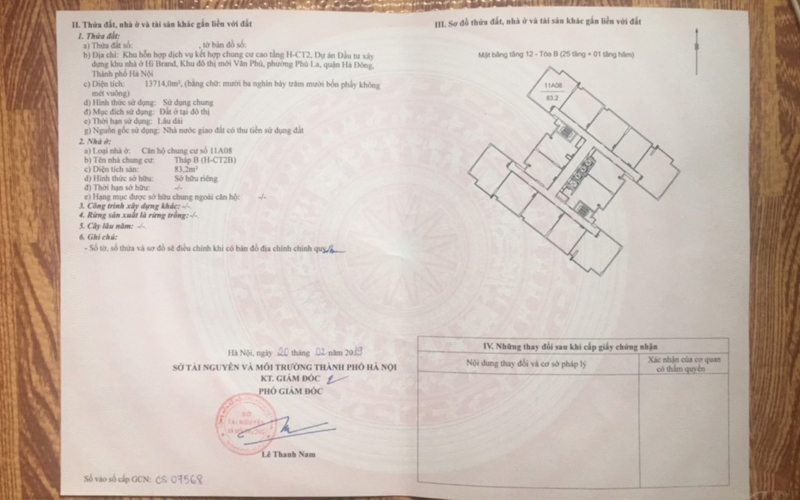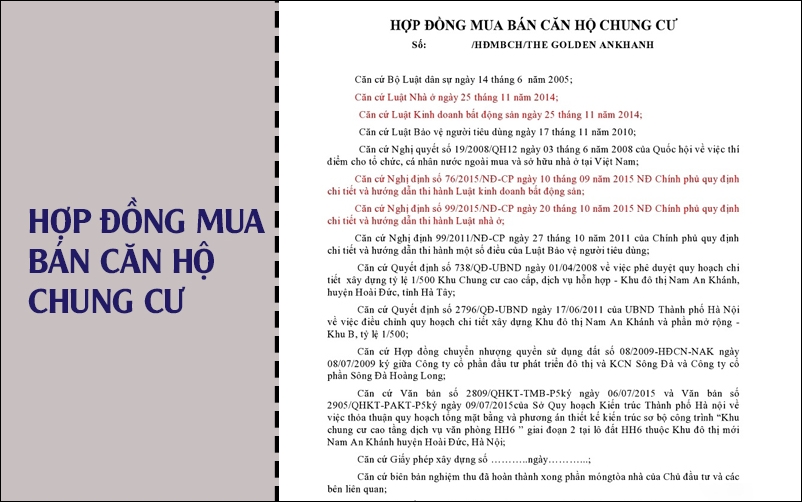What are the procedures and paperwork required for transferring ownership of a condominium apartment, and how can one complete these procedures correctly? Let’s find out together in this article!
1 What is a transfer of ownership?

Transfer of ownership refers to the transfer of assets from an individual or organization to another individual or organization. The receiving party will then have the right to own and enjoy the benefits associated with the assets, similar to the previous owner.
The transferring party will receive a monetary value equivalent to the value of the assets as agreed upon by both parties.
2 What is a condominium pink book?

A condominium pink book is a booklet with a pink cover, issued by the Ministry of Construction to individuals living in condominiums, as stipulated in Article 11 of the 2005 Housing Law.
The pink book recognizes the scope of ownership as the house and the land use rights, excluding other types of land such as gardens or production land. Another term for the condominium pink book is the “Certificate of Ownership of House and Land Use Rights”.
3 Conditions for transferring ownership of a condominium
Transfer of ownership of a condominium apartment without a purchase contract

In this case, the object of the transfer is a project that is being sold by the investor on a primary basis, so the apartment is not yet completed and there is no official purchase contract.
Therefore, the transfer will be entirely dependent on the permission of the investor, and the buyer only needs to pay about 10-20% of the apartment’s value.
Transfer of ownership of a condominium apartment with a purchase contract but without a pink book

This is a common type of transaction in the real estate market. The transfer is carried out with the acceptance of the investor and the value-added tax invoices of the apartment. The seller needs to settle all the invoices, and the buyer has the obligation to the investor as stipulated.
Transfer of ownership of a condominium apartment with a pink book

The transfer is carried out between the buyer and the seller without the intervention of the investor. Both parties will agree and have the contracts notarized by a competent authority.
4 Procedures for transferring ownership of a condominium apartment
First, before proceeding with the procedures and related paperwork, both the buyer and the seller need to verify the legality and safety of the investor and the seller of the apartment.
The seller must ensure the completion and fulfillment of their obligations regarding the payment of the apartment at the time of the transfer. At the same time, both parties need to clarify the transfer and name change costs for the condominium apartment.
The specific steps may vary depending on the type of transfer. The following is the order of procedures for each case.
Procedures for transferring ownership of a condominium apartment without a purchase contract

Both the seller and the buyer agree on the price and the amount of the deposit. Usually, the deposit amount will depend on the value of the property but will range from VND 50,000,000 to VND 20,000,000.
The seller submits the request form to the investor.
Upon receiving the transfer request, the investor will, within 7-15 working days, prepare the necessary documents for the name transfer. The investor will then witness the confirmation between the buyer and the seller, and the buyer will make the payment to the seller.
At this point, the seller will refund the deposit to the buyer and return all receipts and documents related to the apartment to the investor.
Once the procedure with the seller is completed, the investor will schedule an appointment with the new buyer to return the deposit receipt and other receipts under the investor’s name. Then, proceed with the name transfer procedures for the pink book.
Procedures for transferring ownership of a condominium apartment without a pink book

The transfer document includes details about the price, payment method, and time of delivery.
The following documents need to be notarized:
- Original copy of the condominium purchase contract between the investor and the owner.
- Personal identification documents such as ID card, citizen identification card, or household registration book.
- Original copy of the transfer document.
- Handover minutes from the investor.
- Marriage certificate or other documents proving marital status.
- Original copy of the document confirming that the apartment does not have a pink book yet.
Prepare the following documents:
- Original copy of the transfer document.
- ID card of the apartment seller.
- Personal income tax return form (available in a standard format).
Bring the above documents to the local tax office for filing. The personal income tax is calculated as 2% of the transfer price of the apartment. In the case that the transfer price is lower than the apartment price, the above method of calculation will still apply.
Prepare the following documents:
- Copy of the ID card of the apartment seller.
- Original copy of the apartment purchase contract between the investor and the seller.
- 5 original copies of the transfer document from the seller.
Once the transfer document is confirmed, the investor will return the following documents to the submitting party:
- Original copy of the condominium purchase contract with signatures.
- Tax payment receipt.
- Confirmed transfer document, including 2 originals – one for the buyer and one for the seller.
The time to receive the certificate of ownership of the apartment will depend on the agreement between the two parties. Before receiving the certificate, it is advisable to carefully check the documents to facilitate any necessary corrections. Thus, the name transfer procedure for the pink book is completed.
Procedures for transferring ownership of a condominium apartment with a pink book

The matters that need to be agreed upon include the amount of the deposit, the specific time for the delivery of the apartment, the time for preparing the notarized contract, the specific taxes, and the tax obligations of each party.
The deposit process must be witnessed by others, specifically 2-3 people, to ensure transparency and protect the interests of both parties.
Step 2 Draft the notarized contract for the purchase and transfer of the condominium
The following documents will be required for notarization:
- ID card.
- Certificate of ownership of the apartment.
- Household registration book of the owner.
- Stamp duty declaration form.
- Marriage certificate or other documents proving marital status.
- Apartment floor plan.
Each party should prepare one original and one copy of each of the above documents to proceed with the contract signing at the notary office.
Step 3 File for taxes at a state agency
Prepare the following documents:
- ID card.
- Notarized transfer contract.
- Stamp duty declaration form.
- Certificate of ownership of the house.
- Household registration book of the buyer and seller, and tax declaration form (available in a standard format).
The tax filing process at the state agency will take about 7 days, but after signing the contract, you must go to the state agency to file taxes within 10 days. If the tax filing is not done or is not in accordance with the regulations, the transfer process will be canceled.
Prepare the following documents:
- ID card, household registration book, or real estate registration form.
- Certificate of ownership of the apartment from the seller.
- Old and new stamp duty declaration forms.
- Notarized transfer contract.
Usually, after submitting the complete set of documents to the state agency, you will be given an appointment to receive the certificate and the new ownership certificate of the apartment within 3 weeks. Thus, the procedures for the transfer of ownership are completed.
The above is the process and procedures for transferring ownership of a condominium apartment. Stay tuned for more useful information!
See also:






























